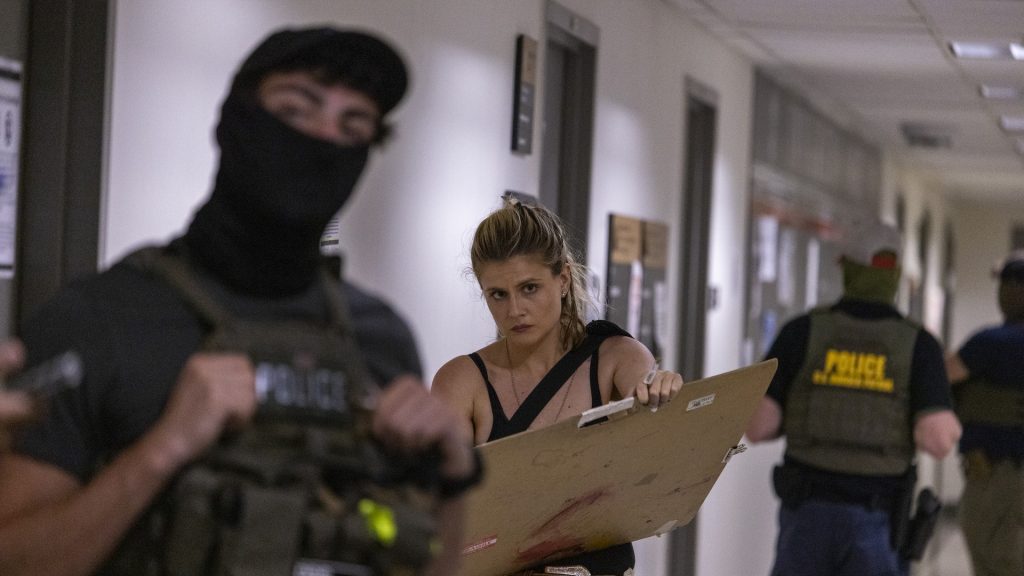Trump called her work ‘genius’. Now this artist documents his deportation push

NEW YORK — Isabelle Brourman’s art has been likened to that of the German Expressionists, painters like Ernst Kirchner and Max Beckmann who documented post-World War I Germany with fierce and vibrant brushstrokes. Major art collectors have purchased Brourman’s sketches, she had a solo show at New York City’s Will Shott Gallery, and her work will be featured at Art Basel Miami in December.
What Brourman describes as the “Tasmanian-devil glamour” of her work has won praise from art critics, media figures and even the president of the United States.

But Brourman has carved out an unlikely niche: finding art in the banal confines of U.S. courtrooms. She started with sketching high-profile cases, such as the actor Johnny Depp’s defamation lawsuit against his former wife, Amber Heard. She sketched Donald Trump’s civil and criminal trials last year and even visited Mar-a-Lago, where Trump sat for a portrait. “There’s a lot of genius in the work,” Trump said.
Now Brourman, 32, is documenting how Trump’s immigration policy plays out. Most weekdays since July, she has been in New York City’s federal immigration court, a main hub of Trump’s plan to deport millions of people living in the United States without legal status.
Brourman’s sketches — bold, sometimes chaotic images of judges, of federal agents, of immigrants awaiting their fates — are the only visual evidence of the dramas that unfold daily.
“She’s an artist who became a sketch artist,” the art collector Dakis Joannou, who owns multiple works by Brourman, told Straight Arrow News. Joannou first saw her work on art critic Jerry Saltz’s Instagram. Joannou said it was her breaking of barriers that piqued his interest.
“How do you get there? How does it work? Do you have a magazine behind you? She just had nobody.” He laughed. “She was a very special case.”
To Brourman, who has art degrees from the University of Michigan and Pratt Institute, it is important that she is present in immigration court to bear witness.
“The high-profile trials are where artists are being sent and paid to document,” Brourman told SAN. “But the immigration court was empty. I was the only one — and am the only one — there.”
‘The volatility of a system disrupted’
Trump says his deportation agenda is intended to ensure public safety and national security. But at 26 Federal Plaza in lower Manhattan, the immigration courtrooms and the nearby hallways and waiting rooms have served as a stage for violent encounters, one where masked and armed Immigration and Customs Enforcement (ICE) agents lurk.
This fall, an agent threw a mother to the ground while her children watched, and she pleaded for mercy for her husband. Another agent shoved photographers, with one of the photojournalists landing in the hospital for medical treatment.
It is an unusual place for an artist carrying an oversized clipboard, specialty paper, watercolors, colored pencils, gel pens, graphite and ink.

When she started her daily routine at the courthouse, Brourman said, a judge told her that in 30 years there, he had never seen an artist in the immigration courtrooms. She successfully argued her case.
“I argued it to the court administrators — that’s the role of a courtroom artist, to supplement in the absence of photography,” she said.
In these courtrooms, a cadence of the legal system and immigration proceedings plays out.
“That’s the most amazing part of the courtroom,” Brourman said. “You’re in a space that’s held up the country, the republic, and it’s a reason why the republic exists.”
But the artist witnessed a powerful change.
This year, Trump doubled down on ICE with a mega-bill that earmarked $170 billion for immigration enforcement and border security initiatives, including $45 billion for immigration detention. ICE is detaining almost 60,000 people, and 20 people have died in the agency’s custody this year, the most in the last two decades, according to NPR.
At 26 Federal Plaza, ICE agents line the hallways outside immigration hearing courtrooms. Lawyers tightly clutch their clients, their arms wrapped around them, as they walk down these corridors, passing masked agents carrying Glocks. Brourman said that it’s in this space — the hallways open to the public — where agents arrest and detain people who are leaving their courtroom hearings.
“It’s not normal what’s happening here,” Brourman said. “[Children are] seeing ginormous masked and armed individuals that hover and threaten to tear their families apart. … These are semi-uniformed agents that have a crazy amount of power, and everybody around them is in this severance zone.”
It is this severance zone that Brourman is particularly interested in. “As an artist,” she said, “that tension between the procedure and the interjection [by ICE], that’s what I’m exploring — the true emotional reality and the volatility of a system interrupted.”

Brourman was in the courtroom on Aug. 25 when Jamal Fadel, an activist from the Moroccan-occupied Western Sahara, arrived with his family for his immigration hearing.
“I exited for the bathroom, and when I passed back through the waiting room, it was filled with agents, so I decided to draw in the waiting room,” she said. “Then Fadel came out [of the courtroom]. There were agents waiting for him at the door. They said he’s going to come with them.”
The room was so crowded that Brourman couldn’t hold her board and needed to switch to a smaller sketchbook.
“There were so many agents in the waiting room with the mother and the baby,” she said. Agents “were shaking the stroller so hard … their guns in their holsters and you don’t know what’s going to happen.”
Fadel, she said, reached for his baby, but the agents jumped in, trying to grab Fadel but also holding onto the stroller. In the commotion, the agents eventually cuffed Fadel and placed him under arrest.
“I drew the wife and the baby,” Brourman said, “while she cried and collected herself.”
Witnessing the episode shook Brourman’s belief in the judicial system.
“This is a warped reality that exists in a bureaucratic building in the center of the melting pot,” she said. “This space feels like a mock courtroom at this point. It renders the courtroom mock because it doesn’t matter what’s spoken in that [court] room. If somebody is on a list, they aren’t going to be seeing that judge again. … It’s not real justice. It’s not the justice process.”
“We have no actual idea why some days certain people from certain countries are taken, why some people are spared,” Brourman said. “It’s still very much a mystery.”
‘The most bizarre ecosystem’
Brourman has access to both the courtrooms and the hallways, documenting each world. Outside the courtrooms, photographers, journalists and Brourman share an unpredictable work environment with the federal agents, most of whom cover their faces to hide their identities.
“This has got to be the most bizarre ecosystem that exists,” Brourman said. “You’re familiar with people that you don’t know what they look like [but] they know your social media, your whereabouts.”
The agents call her by her nickname, Izzy, even though “I didn’t go by my nickname [at the courthouse],” she said. “We’re standing with strangers that we know.”

As an artist, her work has a utility it hasn’t had before.
“I have eyes in the courtroom where no one else has eyes,” she said.
The art world has taken notice. Will Shott, whose gallery staged a solo show of her sketches, described her work as important.
“There ‘s so much detail in them, and different quotes, and different scenes,” Shott told SAN. “It is this longstanding traditional art form that she’s doing in a different way.”
Shott said Brourman crosses lines into different fields — “law, politics, fine art, fashion. It reached a lot of people that don’t care about gallery shows or contemporary art. … It touched a much broader audience than a normal show would.”
“I think she’s documenting parts of history in a way that hasn’t been documented before,” Shott said. “She got a lot of institutional recognition, and I think there’s a big place for it in museums. … There’s a lot of types of museums that would benefit from this type of work.”
Joannou, the art collector who owns multiple works by Brourman, said, “To have the nerve, the courage, and the will to really break into that system … it’s really impressive what she’s doing.”

Still, Brourman wakes up early to make sure she’s at the courthouse by 8:30 a.m. If she’s not there to capture these scenes, she feels no one will.
“I feel a real tug every single day to try to get down there to get what I can,” Brourman said. “This is the quietest, loudest thing I’ve ever heard. … What does the law really mean right now, if it’s so flexible?”
The post Trump called her work ‘genius’. Now this artist documents his deportation push appeared first on Straight Arrow News.





